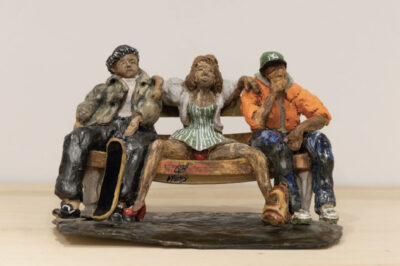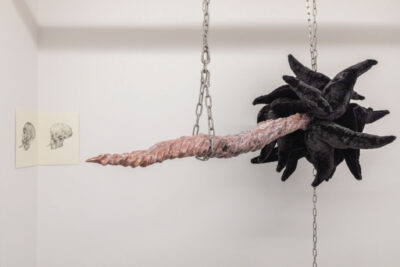March 1 – March 4
80WSE Gallery
Curator: Katie Svensson
Artists: Elsa Stern & Echo Yan
Nature or Nurture? The long debated question may be more aptly considered today in the struggle to overcome internalized thoughts and behaviors— residues of previous generations—that no longer serve to benefit our ever expanding world. Both artists explore this terrain of the normative, the internalized truths that guide us through our daily lives and influence the meanings we derive from our experiences, through the corporeal; their insides come out to challenge our conception of the ‘obscene’, ‘proper’ behaviors, and our anthropocentric tendencies, all of which are intimately intertwined with our society’s patriarchal, heteronormative, and white supremacist foundations.
Elsa Stern captures the discomfort created by the disjuncture between the nurture of the normative and the nature of knowing ourselves through images of motherhood, infancy, and wounded bodies. In her Untitled painting of a collapsed, downcast, pregnant mother, whose transparent belly reveals the life inside her tugging at a wishbone, Stern alludes to an underlying conflict between parent and child: the wishes and hopes, of the parent for their child’s life, and the child’s own wishes and hopes for them- selves. Similarly, in her painting Scary When Made to Treat Opinion as Fact, a heteronormative love story illustrated with chalk drawings surrounds a mother caressing her daughter’s hair. The young girl reads, ignoring her mother’s hetero-normative ideation, indicated by the scene between the girl’s legs which clearly shows two girls holding hands in a heart. These conflicting sides struggle against each other in a battle of prominence, leaving scars and war wounds, exemplified by Critical Hit’s memento mori.
Echo Yan’s work also considers both the formation of the self and the meta- morphosis of the body within specific contexts, examining it physically and metaphorically. In works such as Mutterleib, German for womb, a 3D printed infant lies in a curved container; they are surrounded by various independent, cylindrical swirls, brushed with the blood red of the veins, evoking used-tampons. Through the distorted womb and its discarded materials (infant and tampons), Yan attempts to destabilize our notions of the female body by conflating creation and destruction of-life and non-life-pregnancy and period. Yan’s piece Please Do Not Feed, a menacing mask with an outstretched tongue accompanied by pencil drawings of skulls in profile, exemplifies how the human body was domesticated, in the same way that animals have been, and physically changed to adapt to social societies and communal living: we no longer resemble, or need to be, the fierce predators that our ancestors once embodied. By equating this human and animal process of trans- formation, Yan confronts the viewer with their animality and causes them to question the validity of our distinctive hierarchy of beings, which places humans at the top and positions them as completely separate from other living creatures.
Ultimately, Stern and Yan’s works ask us to re-examine how normative modes of nurturing, and the subsequent internal biases we acquire, impact the elusive ‘human condition’ and the repercussions of our overwhelmingly anthropocentric mindsets.

